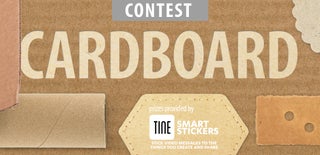Introduction: Cardboard Sofa
Want affordable furniture? Easily stored? Easily shipped? Easily replaced if it breaks? Sustainable? Recyclable?
Perhaps I have the answer!
Step 1: Prototype
Before I start any project I like to make a quick prototype to work out any problems I may have when i produce my final design. For this piece I used some old cardboard I had and made the cuts using a Stanley knife. By using this piece for about a week I felt that although the form was correct, the weight of the card was too heavy. I needed to make it from lighter card. Also, to ensure adequate support at the back, I deceided to evenly space the card, rather than rely on just two main spines, as seen in this prototype.
Step 2: Production
I had thought of making the final piece using the same method I had employed previously however given the clean lines I wanted and the precision required, I felt I needed to get the piece produced by machine. I research in my local area and found a packaging company that had just invested in a CNC cutter and were keen to try different designs to experiment with its capabilities, speed, accuracy etc and so my project fitted well within their needs. We agreed that if I could prodcue a 2D CAD file, they would produce the piece. The machine used was a Kongsberg XL24.
Step 3: Assembly
Following the cutting process, it was a simple procedure to just slide each of the pieces together. The sofa was made using 4 individual pieces multiple times. I kept the design simple to ensure that replacment parts were simple to identify and easy to insert. The four parts are 1. Seat, 2. Arms, 3. Centre, 4. Back. If this item were to be manufactured and produced at a large scale, it would be very easy to just produce multiples of these parts and assemble the overall sofas using a combination of the 4 parts. These parts can also be used in other pieces I designed. These can be seen later.
Step 4: Pre-Cushions
Fully assembled the sofa is strong enough and large enough to seat 3 fully grown adults. In case of damaged or ripped pieces, each section can easily be removed and replaced.
Step 5: Finished
Here the finished piece can be seen with cushions and with other pieces to compliment the sofa. A simple coffee table is made using the same technique and a sheet of 8mm plexigalss added to the top. A single seater was also produced, using 2 of the 4 existing pieces used for the sofa.
BUT WHY?!
My idea was that given the increase in online purchasing, the main cost of buying furniture can often be associated with the shipping. By creating furntiure in this way, it is much lighter and much easier managed and it can also be assembled/disasembled by one person. In the last picture a measuring tape shows the width of the single seater AND coffee table, when broken down - only 250mm in width.
THANKS FOR READING!

Runner Up in the
Cardboard Contest 2016













